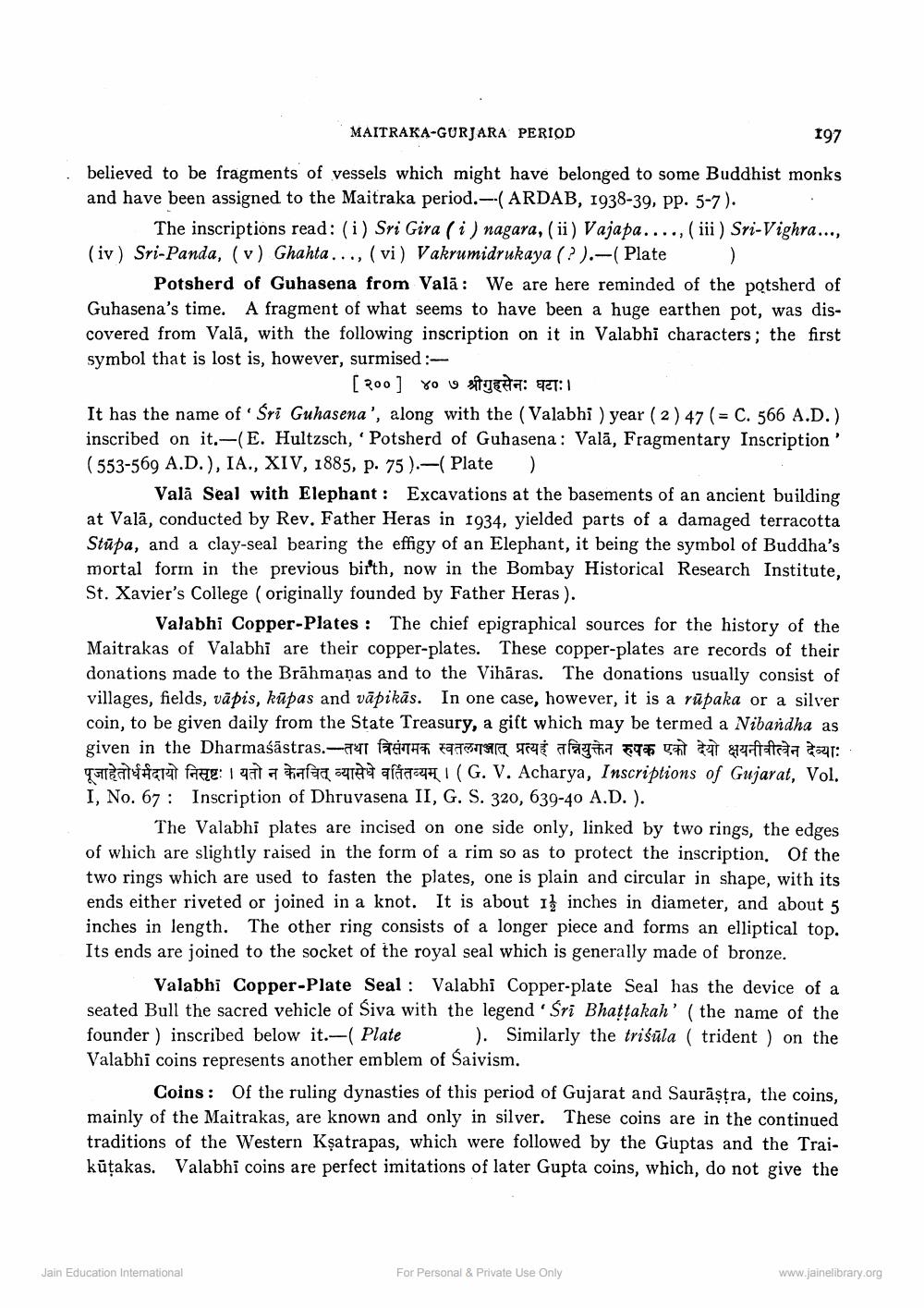________________
MAITRAKA-GURJARA PERIOD
197 believed to be fragments of vessels which might have belonged to some Buddhist monks and have been assigned to the Maitraka period.-( ARDAB, 1938-39, pp. 5-7).
The inscriptions read: (i) Sri Gira (i ) nagara, (ii) Vajapa...., (iii) Sri-Vighra..., (iv) Sri-Panda, (v) Ghahta ..., (vi) Vakrumidrukaya (?).-( Plate )
Potsherd of Guhasena from Valä: We are here reminded of the potsherd of Guhasena's time. A fragment of what seems to have been a huge earthen pot, was discovered from Valā, with the following inscription on it in Valabhi characters; the first symbol that is lost is, however, surmised :
[800] yo u situga: T: 1 It has the name of Sri Guhasena', along with the (Valabhi ) year ( 2 ) 47 ( = C. 566 A.D.) inscribed on it.-(E. Hultzsch, 'Potsherd of Guhasena: Valā, Fragmentary Inscription' (553-569 A.D.), IA., XIV, 1885, p. 75).- Plate )
Valā Seal with Elephant : Excavations at the basements of an ancient building at Valā, conducted by Rev. Father Heras in 1934, yielded parts of a damaged terracotta Stūpa, and a clay-seal bearing the effigy of an Elephant, it being the symbol of Buddha's mortal forin in the previous birth, now in the Bombay Historical Research Institute, St. Xavier's College (originally founded by Father Heras).
Valabhi Copper-Plates : The chief epigraphical sources for the history of the Maitrakas of Valabhi are their copper-plates. These copper-plates are records of their donations made to the Brāhmaṇas and to the Vihāras. The donations usually consist of villages, fields, vāpis, kūpas and vāpikās. In one case, however, it is a rūpaka or a silver coin, to be given daily from the State Treasury, a gift which may be termed a Nibandha as given in the Dharmaśāstras.-41 PEPÅTAR 1975 at afaggia Fyn am ftatcaa aar: Theater fare qat a palaa #aftaghi (G. V. Acharya, Inscriptions of Gujarat, Vol. I, No. 67 : Inscription of Dhruvasena II, G. S. 320, 639-40 A.D.).
The Valabhi plates are incised on one side only, linked by two rings, the edges of which are slightly raised in the form of a rim so as to protect the inscription. Of the two rings which are used to fasten the plates, one is plain and circular in shape, with its ends either riveted or joined in a knot. It is about it inches in diameter, and about 5 inches in length. The other ring consists of a longer piece and forms an elliptical top. Its ends are joined to the socket of the royal seal which is generally made of bronze.
Valabhi Copper-Plate Seal : Valabhi Copper-plate Seal has the device of a seated Bull the sacred vehicle of Siva with the legend 'Sri Bhattakah' (the name of the founder) inscribed below it.—( Plate ). Similarly the triśūla ( trident) on the Valabhi coins represents another emblem of Saivism.
Coins : Of the ruling dynasties of this period of Gujarat and Saurāştra, the coins, mainly of the Maitrakas, are known and only in silver. These coins are in the continued traditions of the Western Kșatrapas, which were followed by the Guptas and the Traikūtakas. Valabhi coins are perfect imitations of later Gupta coins, which, do not give the
Jain Education Intemational
For Personal & Private Use Only
www.jainelibrary.org




